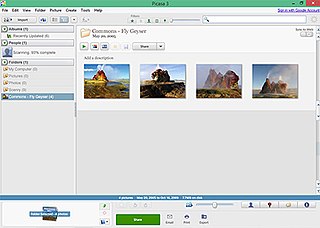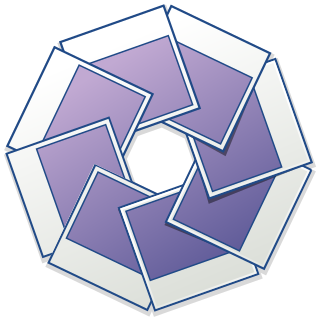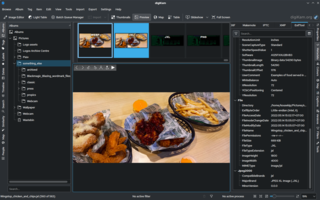Desktop applications
| Name | License | Platform | Languages | Resizing | Upload | Output | IPTC Support | GeoTagging Support | Tags Categories Keywords |
|---|---|---|---|---|---|---|---|---|---|
| jAlbum | Proprietary | Windows, Mac, Linux | Multilingual | Automatic | FTP | XHTML, HTML5, CSS | Yes | Yes |
An editor has nominated this article for deletion. You are welcome to participate in the deletion discussion , which will decide whether or not to retain it. |
A photo gallery software is a computer software that let users to manage and display photos and pictures and, in some cases, videos and other multimedia content. Features could include classify, display, share, tagging, etc.
The following is a comparison of photo gallery publishing software. Some are desktop applications, others are server side applications.
For software that just allows you locally organize photos in your filesystem see image organizer.
| Name | License | Platform | Languages | Resizing | Upload | Output | IPTC Support | GeoTagging Support | Tags Categories Keywords |
|---|---|---|---|---|---|---|---|---|---|
| jAlbum | Proprietary | Windows, Mac, Linux | Multilingual | Automatic | FTP | XHTML, HTML5, CSS | Yes | Yes |
| Name | License | Platform | Languages | Resizing | Upload | Output | IPTC Support | GeoTagging Support | Tags Categories Keywords | Dynamic Image Processing | Access Control | Face Recognition | LDAP support | Version |
|---|---|---|---|---|---|---|---|---|---|---|---|---|---|---|
| Gallery Project | GPL | PHP/MySQL, (PostgreSQL, Oracle, IBM Db2, Microsoft SQL Server only in 2.x version) | Multilingual | Automatic (GD/ImageMagick) | Local filesystem, HTTP, Java applet, Gallery Remote, Picasa 2, Import from Gallery 1.x, Windows XP Publishing Wizard, Local server, GLoSS, WebDAV (as of 2.2) | XHTML 1.0 Strict, CSS | Yes, in G2 | module | Yes, keywords in G2 | No | No, as of G3 | 3.1.3 (June 4, 2020) [±] | ||
| MediaGoblin | AGPLv3 | Python/PostgreSQL | Multilingual | Automatic | HTTP, Android (just under a discontinued client) | HTML5 | Yes | Yes, tags and collections | Yes, by controlling if registrations are allowed or not | 0.12.0 "Potions" [1] (September 18, 2021) [±] | ||||
| ownPhotos (ownCloud plugin) | MIT License [2] | Python/Django, React | Yes | Yes | Yes | |||||||||
| picdrop | PHP/MySQL | Multilingual | Automatic | HTTP, FTP | HTML5 | Yes | No | No | Yes | No | No version numbers available | |||
| Piwigo | GPL | PHP/MySQL | Multilingual (56 languages) | Automatic (GD/ImageMagick), up to 9 sizes | HTTP, FTP, local filesystem, Flash, Picasa, iPhoto, Digikam, Shotwell, Lightroom, iPhone/iPad and Android | HTML 4.01 or HTML 5, CSS 2 (Complies with W3C specifications), theme for mobile devices | Yes | plugin for Google Maps or plugin for OpenStreetMap | Yes | Yes resize, sharpen, crop, rotate | Yes | plugin | 14.0.0 (December 11, 2023) [±] | |
| Chevereto | AGPLv3 | PHP/MySQL | Multilingual (35 languages) | Automatic | HTTP, API | HTML 5 | Yes | Yes | Yes | No | Yes | No | No | 4.0.7 (February 6, 2023) |
Adobe Photoshop is a raster graphics editor developed and published by Adobe for Windows and macOS. It was originally created in 1987 by Thomas and John Knoll. Since then, the software has become the most used tool for professional digital art, especially in raster graphics editing. Owing to its fame, the program's name has become genericised as a verb although Adobe disapproves of such use.

Vector graphics are a form of computer graphics in which visual images are created directly from geometric shapes defined on a Cartesian plane, such as points, lines, curves and polygons. The associated mechanisms may include vector display and printing hardware, vector data models and file formats, as well as the software based on these data models. Vector graphics is an alternative to raster or bitmap graphics, with each having advantages and disadvantages in specific situations.
iPhoto is a discontinued digital photograph manipulation software application developed by Apple Inc. It was included with every Mac computer from 2002 to 2015, when it was replaced with Apple's Photos application. Originally sold as part of the iLife suite of digital media management applications, iPhoto is able to import, organize, edit, print and share digital photos.

An image viewer or image browser is a computer program that can display stored graphical images; it can often handle various graphics file formats. Such software usually renders the image according to properties of the display such as color depth, display resolution, and color profile.

Picasa was a cross-platform image organizer and image viewer for organizing and editing digital photos, integrated with a now defunct photo-sharing website, originally created by a company named Lifescape in 2002. "Picasa" is a blend of the name of Spanish painter Pablo Picasso, the word casa and "pic" for pictures.
Fusker is a type of website or utility that extracts images in bulk from a website by systematically loading and downloading images following a pattern in the website's URL scheme. Fusking or fuskering is often used to extract private and nude photos without consent of the owner.

Image sharing, or photo sharing, is the publishing or transfer of digital photos online. Image sharing websites offer services such as uploading, hosting, managing and sharing of photos. This function is provided through both websites and applications that facilitate the upload and display of images. The term can also be loosely applied to the use of online photo galleries that are set up and managed by individual users, including photoblogs. Sharing means that other users can view but not necessarily download images, and users can select different copyright options for their images.
digiKam is a free and open-source image organizer and tag editor written in C++ using the KDE Frameworks.

F-Spot is a image organizer, designed to provide personal photo management for the GNOME desktop environment. The name is a play on the word F-Stop.
Raster graphics editors can be compared by many variables, including availability.
Aperture is a discontinued professional image organizer and editor developed by Apple between 2005 and 2015 for the Mac, as a professional alternative to iPhoto.
A camera raw image file contains unprocessed or minimally processed data from the image sensor of either a digital camera, a motion picture film scanner, or other image scanner. Raw files are so named because they are not yet processed, and contain large amounts of potentially redundant data. Normally, the image is processed by a raw converter, in a wide-gamut internal color space where precise adjustments can be made before conversion to a viewable file format such as JPEG or PNG for storage, printing, or further manipulation. There are dozens of raw formats in use by different manufacturers of digital image capture equipment.

Adobe Lightroom is an image organization and image processing software developed by Adobe as part of the Creative Cloud subscription family. It is supported on Windows, macOS, iOS, Android, and tvOS. Its primary uses include importing, saving, viewing, organizing, tagging, editing, and sharing large numbers of digital images. Lightroom's editing functions include white balance, presence, tone, tone curve, HSL, color grading, detail, lens corrections, and calibration manipulation, as well as transformation, spot removal, red eye correction, graduated filters, radial filters, and adjustment brushing. The name of the software is based on darkrooms used for processing light-sensitive photographic materials.

Windows Photo Gallery is a discontinued image organizer, photo editor and photo sharing program. It is a part of Microsoft's Windows Essentials software suite. The product has been unavailable for download since January 10, 2017, as the Windows Essentials line of products have been discontinued.

An image organizer or image management application is application software for organising digital images. It is a kind of desktop organizer software application.
jAlbum is cross-platform photo website software for creating and uploading galleries from images and videos. jAlbum has built-in support for organizing and editing images, but with focus on flexible presentation. The resulting albums can be published on jalbum.net or on the user's own website. jAlbum software has been used to create over 32 million photo galleries, with over one million users. Majestic.com counts over 118 million backlinks to jalbum.net

Picture Motion Browser (PMB) is a software application from Sony for organizing and editing digital photos. In 2012, PMB was succeeded by Sony's PlayMemories Home.
Darktable is a free and open-source photography application and raw developer. Rather than being a raster graphics editor like Adobe Photoshop or GIMP, it comprises a subset of image editing operations specifically aimed at non-destructive raw image post-production. It is primarily focused on improving a photographer's workflow by facilitating the handling of large numbers of images. It is freely available in versions tailored for most major Linux distributions, macOS, Solaris and Windows and is released under the GPL-3.0-or-later.

GNU MediaGoblin is a free, decentralized Web platform for hosting and sharing many forms of digital media. It strives to provide an extensible, federated, and freedom-respectful software replacement to major media publishing services such as Flickr, DeviantArt, and YouTube.

Guvcview is a webcam application, i.e. software to handle UVC streams, for the Linux desktop, started by Paulo Assis in 2008. The application is written in C and is free and open-source software released under GPL-2.0-or-later.